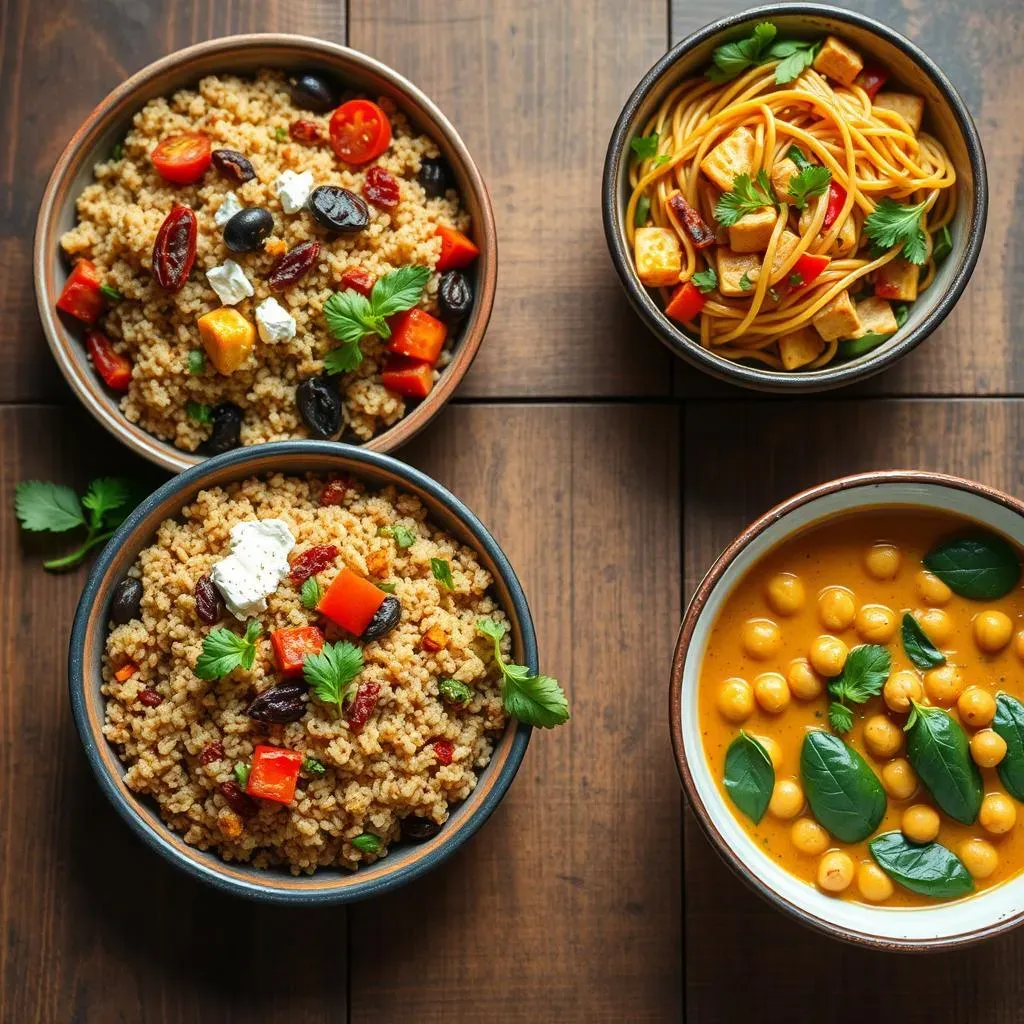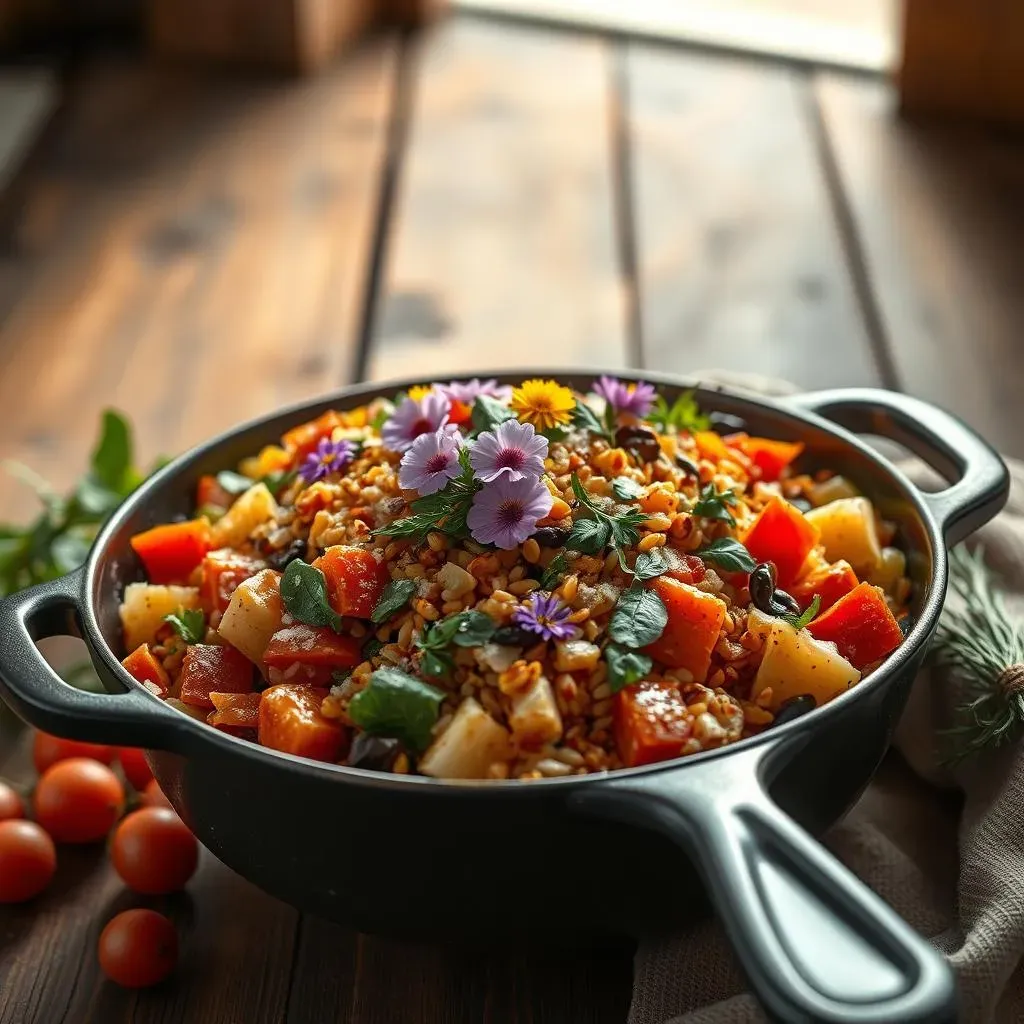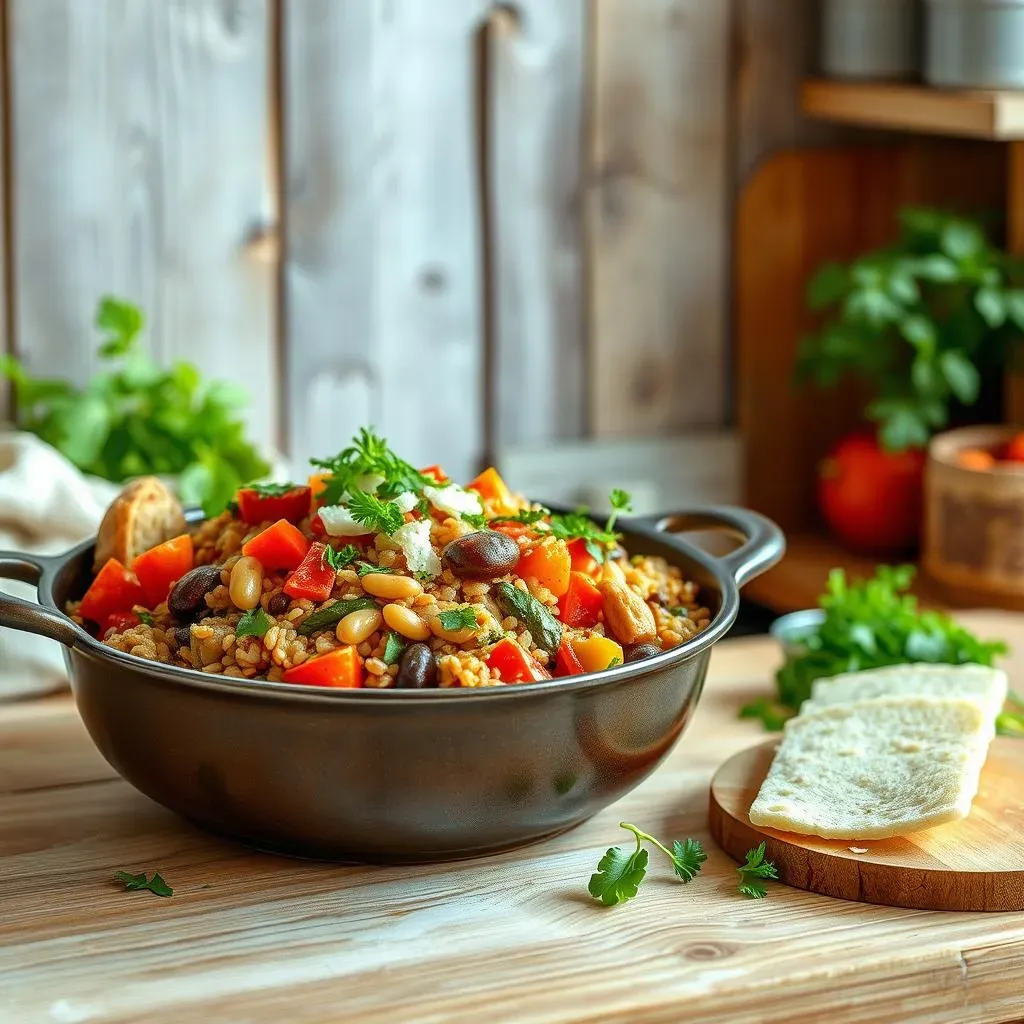Table of Contents
Tired of spending hours in the kitchen and then facing a mountain of dishes? I get it! That's why I'm so excited to share the magic of healthy vegetarian one-pot dinners with you. These aren't just any meals; they're flavor-packed, nutritious, and incredibly easy to make, all while keeping the cleanup to a minimum. Think of it: vibrant veggies, hearty grains, and aromatic spices all mingling together in a single pot, creating a symphony of taste and texture. Forget complicated recipes and endless scrubbing; this is about enjoying delicious, wholesome food without the fuss. In this article, I'll be your guide, revealing why one-pot cooking is a total game-changer, sharing some of my favorite healthy vegetarian one-pot dinner recipes, and providing you with all the tips you need to become a one-pot master. We'll explore how to make these meals a regular part of your routine, ensuring you always have a simple, satisfying, and healthy meal option at your fingertips. Get ready to say goodbye to kitchen chaos and hello to delicious, effortless eating!
Why OnePot Vegetarian Meals are a Game Changer

Why OnePot Vegetarian Meals are a Game Changer
Simplicity and Speed
Let's be real, who has time for complicated cooking these days? I know I don't! One-pot vegetarian meals are my secret weapon for busy weeknights. It's like a magic trick: throw everything into one pot, let it simmer, and boom – dinner is served. No mountains of dirty dishes, no complicated steps, just pure, delicious simplicity. It's the kind of cooking that fits perfectly into a hectic schedule, allowing you to enjoy a home-cooked meal without feeling like you've spent your entire evening in the kitchen. Trust me, once you experience the ease of one-pot cooking, you'll never look back.
Nutrient Powerhouse
Don't let the simplicity fool you; these meals are nutritional powerhouses. You get all the goodness of veggies, grains, and legumes all in one go. Because everything cooks together, the flavors meld beautifully, and you don't lose any of those precious vitamins and minerals. It’s a great way to pack your diet with fiber, protein, and essential nutrients, all while enjoying a mouthwatering meal. It's like having a complete and balanced meal in a single pot, making healthy eating not just easy, but incredibly tasty too.
Benefit | Description |
|---|---|
Time-Saving | Quick prep and minimal cleanup. |
Nutrient-Rich | Retains vitamins and minerals. |
Flavorful | Ingredients meld together beautifully. |
Versatile | Adaptable to various tastes and diets. |
Versatility and Creativity
The best part? One-pot cooking is incredibly versatile. You can use whatever veggies you have on hand, experiment with different spices, and tailor the meal to your exact taste. One day it could be a hearty lentil stew, the next a creamy tomato pasta, and the next an exotic curry. It's a fantastic way to get creative in the kitchen and make healthy eating an exciting adventure. Plus, it's a great way to use up leftovers and prevent food waste. I find myself always looking forward to what kind of one-pot creation I'm gonna cook next.
Top Healthy Vegetarian OnePot Dinner Ideas

Top Healthy Vegetarian OnePot Dinner Ideas
Mediterranean Quinoa Bowl
Picture this: fluffy quinoa, sun-dried tomatoes, Kalamata olives, crumbled feta (or a vegan alternative!), and a generous squeeze of lemon. It's like a vacation for your taste buds! This one-pot wonder is packed with protein, healthy fats, and tons of flavor. I love how the salty olives and tangy tomatoes play off the nutty quinoa. It's super easy to customize too; throw in some spinach, roasted peppers, or chickpeas for extra goodness. This dish is proof that healthy can also be incredibly satisfying.
If you want to make it even easier, use pre-cooked quinoa from the store. It's a great way to save some time if you are in a rush! It also works great as a meal prep option for lunch through the week.
Spicy Peanut Noodles with Tofu
Craving something a bit more adventurous? These spicy peanut noodles are where it's at. Imagine: perfectly cooked noodles (I like using whole wheat for extra fiber), crispy baked tofu, a medley of colorful veggies, and a creamy peanut sauce with a kick of sriracha. It's a flavour explosion that'll leave you wanting more. The best part? You can adjust the spice level to your liking, making it perfect for everyone. I like to add some broccoli, carrots and bell peppers, but you can use any veggies you like. I also sometimes put a bit of lime juice to make it more zesty!
"The best meals are those that are both nutritious and delicious." - My Grandma. She always says that!
Coconut Curry with Chickpeas and Spinach
Ready for a cozy, comforting meal? This coconut curry is like a warm hug in a bowl. We're talking: creamy coconut milk, tender chickpeas, lots of spinach, a touch of ginger and garlic, and a blend of aromatic spices like turmeric and cumin. It's a one-pot wonder that's both incredibly flavorful and packed with nutrients. It's also super easy to make it your own: add some lentils for extra protein, swap spinach for kale or add a pinch of chili flakes for more kick. I also love to serve it with some brown rice or naan bread to mop up all that delicious sauce. This one is a true crowd-pleaser.
Recipe | Key Ingredients | Flavor Profile |
|---|---|---|
Mediterranean Quinoa Bowl | Quinoa, sun-dried tomatoes, olives, feta | Fresh, tangy, herby |
Spicy Peanut Noodles | Noodles, tofu, peanut sauce, sriracha | Spicy, savory, nutty |
Coconut Curry | Coconut milk, chickpeas, spinach, spices | Creamy, warm, aromatic |
Tips for Perfecting Your Vegetarian OnePot Cooking

Tips for Perfecting Your Vegetarian OnePot Cooking
Mastering the Art of Layering Flavors
Okay, so one-pot cooking is all about ease, but that doesn't mean we can't build amazing flavor. It's all about layering! Start by sautéing aromatics like onions, garlic, and ginger in a bit of oil or broth. This creates a delicious base for the rest of your ingredients. Then, add your spices, letting them bloom in the heat for a minute or two. This brings out their full flavor potential. Next, add your veggies, followed by your grains or pasta, and finally, your liquids. Layering in this way ensures that each ingredient contributes its unique flavor to the final dish. It's like building a flavor castle, one layer at a time! Trust me, it makes a huge difference.
Don't be afraid to experiment with different combinations. Sometimes, I'll throw in a pinch of red pepper flakes for some heat, or a bay leaf for extra depth. It's all about finding what you love and making it your own. And remember, taste as you go, adjusting seasonings as needed. It's your kitchen, your rules!
Liquid Ratios and Cooking Times
Getting the liquid ratio right is key to a successful one-pot meal. Too little, and your food will burn; too much, and it'll be a soggy mess. The general rule of thumb is to use just enough liquid to cover the grains or pasta you're using. For example, quinoa usually needs a 2:1 ratio of liquid to grain, while rice might need a 1.5:1 ratio. Pasta, on the other hand, often needs enough liquid to be submerged. It's also worth noting that different vegetables will release different amounts of water as they cook, so you might need to adjust the liquid accordingly. Start with the recommended amount, and then add more if needed as things start to cook.
Cooking time also varies depending on the ingredients. Grains and legumes typically take longer to cook than vegetables, so you might want to add them first. Check the package instructions and adjust the cooking time as needed. Remember, one-pot cooking isn't an exact science, so don't be afraid to experiment and adapt the recipes to your preferences. The key is to be patient and keep an eye on your pot.
Tip | Description |
|---|---|
Layer Flavors | Start with aromatics, then spices, then veggies, grains, and liquids. |
Liquid Ratio | Use enough liquid to cover grains or pasta, adjust as needed. |
Cooking Time | Add ingredients that take longer to cook first. |
Dealing With Sticky Situations
Sometimes, no matter how careful you are, things can get a little sticky in the pot. It happens! If your food starts to stick to the bottom, don't panic. First, try adding a little more liquid, stirring gently, and lowering the heat. This will help prevent burning. If that doesn't work, you can try deglazing the pot by adding a splash of wine or broth and scraping the bottom with a wooden spoon. This will help loosen the stuck bits and add extra flavor. It's also really important to use a pot with a good, heavy bottom. This will help distribute the heat evenly and prevent food from sticking in the first place.
Garnishes and Finishing Touches
Okay, your one-pot meal is cooked to perfection, but don't stop there! The right garnishes can take your dish from good to amazing. Think fresh herbs like parsley or cilantro, a sprinkle of toasted nuts or seeds, a squeeze of lemon or lime juice, or a dollop of yogurt or sour cream. These finishing touches not only add extra flavor and texture but also make your meal look more appealing. It's all about the details! I love adding a handful of fresh spinach at the end, letting it wilt slightly for an extra boost of nutrients. And don't forget a pinch of sea salt and some freshly cracked black pepper, they do wonders to make all the flavors pop. It's the little things that make a big difference.
"Cooking is not about perfection, it's about making it your own." - Unknown.
Making Healthy Vegetarian OnePot Dinners a Habit

Making Healthy Vegetarian OnePot Dinners a Habit
Planning Your Weekly One-Pot Menu
Alright, so you've tried a few one-pot recipes, and you're hooked, right? Now, let's talk about making this a regular thing. The key is planning! I like to sit down at the beginning of each week and map out my one-pot dinners. I check what veggies I have in the fridge, what grains and legumes I have in the pantry and then I look for recipes that match those ingredients. It not only saves me time during the week, but it also reduces food waste and makes grocery shopping way easier. Also, it's a great way to ensure I'm eating a balanced diet. I usually try to incorporate a variety of different flavors and cuisines throughout the week, so I don't get bored. It's like having a mini culinary adventure every night!
Batch Cooking and Meal Prepping
Okay, here's a secret weapon: batch cooking! Once you've mastered a few one-pot recipes, try making a double or triple batch on the weekend. This way, you'll have delicious, healthy meals ready to go for the week. It's a total game-changer for busy weeknights when you're short on time and energy. I like to portion out my meals into containers, so they're ready to grab and go. It's like having your own personal meal prep service, without having to pay for it! Plus, batch cooking can actually save you money, because you're less likely to order takeout or eat out when you have a ready-made meal waiting for you at home. It's like a win-win situation!
Tip | Description |
|---|---|
Plan Ahead | Create a weekly menu to streamline cooking. |
Batch Cook | Make extra portions for easy meals later. |
Embrace Flexibility | Don't be afraid to experiment and try new recipes. |
Embracing the One-Pot Lifestyle
Look, making healthy vegetarian one-pot dinners a habit isn't about being perfect. It's about finding a way to make healthy eating easy, enjoyable, and sustainable. Some days I'm feeling like a one-pot pro, other days I'm just throwing things into a pot and hoping for the best. And that's okay! The most important thing is to keep experimenting, keep learning, and keep enjoying the process. Don't be afraid to try new recipes, to modify old ones, and to make mistakes along the way. It's all part of the fun! And remember, cooking should be a joy, not a chore. So, turn up the music, pour yourself a glass of your favorite beverage, and get ready to create some one-pot magic!
"The secret of getting ahead is getting started." - Mark Twain